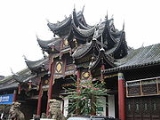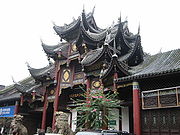
Zigong Salt Museum
Encyclopedia

Chinese character
Chinese characters are logograms used in the writing of Chinese and Japanese , less frequently Korean , formerly Vietnamese , or other languages...
: 自贡市盐业历史博物馆) is a museum
Museum
A museum is an institution that cares for a collection of artifacts and other objects of scientific, artistic, cultural, or historical importance and makes them available for public viewing through exhibits that may be permanent or temporary. Most large museums are located in major cities...
in the salt
Salt
In chemistry, salts are ionic compounds that result from the neutralization reaction of an acid and a base. They are composed of cations and anions so that the product is electrically neutral...
town of Zigong
Zigong
Zigong , ancient name Ziliujing and Gongjing, is a prefecture-level city and the third largest city in Sichuan Province, in southwest China.-Geography:...
(自贡) in Sichuan Province in western China
China
Chinese civilization may refer to:* China for more general discussion of the country.* Chinese culture* Greater China, the transnational community of ethnic Chinese.* History of China* Sinosphere, the area historically affected by Chinese culture...
. It was built in 1736 as the Xiqing Guildhall in the first year of emperor Qianlong, funded by the Shaanxi
Shaanxi
' is a province in the central part of Mainland China, and it includes portions of the Loess Plateau on the middle reaches of the Yellow River in addition to the Qinling Mountains across the southern part of this province...
salt tradesmen, and used a meeting place for salt
Salt
In chemistry, salts are ionic compounds that result from the neutralization reaction of an acid and a base. They are composed of cations and anions so that the product is electrically neutral...
merchants from Shaanxi province the main conduit for the Zigong salt. Another building nearby on the banks of the Fuxi River was the Guild Hall for the salt merchants of the Sichuan
Sichuan
' , known formerly in the West by its postal map spellings of Szechwan or Szechuan is a province in Southwest China with its capital in Chengdu...
province. The guild hall took sixteen years to complete and cost a lot. It has a splendid exterior and exquisite internal structure and decoration, including many delicate stone and wooden carvings. It represents the highest level of architecture technologies of its age and is a symbol of wealth of salt merchants. The interior contains a large courtyard with a stone centerpiece of a dragon and phoenix. The guild hall once often hosted Sichuan opera
Sichuan opera
Sichuanese opera is a type of Chinese opera originating in China's Sichuan province around 1700. Today's Sichuan opera is a relatively recent synthesis of 5 historic melodic styles...
for salt merchants as well as local elites in festivals.
Exterior
The building features elaborate flying eaves and a gilded wooden carved interior based around a large galleried atriumAtrium (architecture)
In modern architecture, an atrium is a large open space, often several stories high and having a glazed roof and/or large windows, often situated within a larger multistory building and often located immediately beyond the main entrance doors...
where plays were once performed. Exhibits
Collection (museum)
A museum is distinguished by a collection of often unique objects that forms the core of its activities for exhibitions, education, research, etc. This differentiates it from an archive or library, where the contents may be more paper-based, replaceable and less exhibition oriented...
in the museum cover the entire history of salt
Salt
In chemistry, salts are ionic compounds that result from the neutralization reaction of an acid and a base. They are composed of cations and anions so that the product is electrically neutral...
mining dating from the Han Dynasty
Han Dynasty
The Han Dynasty was the second imperial dynasty of China, preceded by the Qin Dynasty and succeeded by the Three Kingdoms . It was founded by the rebel leader Liu Bang, known posthumously as Emperor Gaozu of Han. It was briefly interrupted by the Xin Dynasty of the former regent Wang Mang...
.

